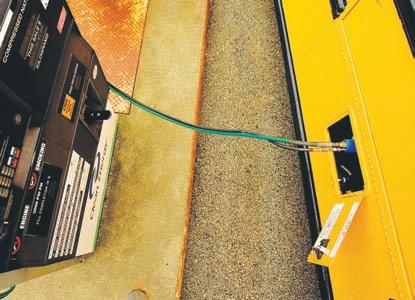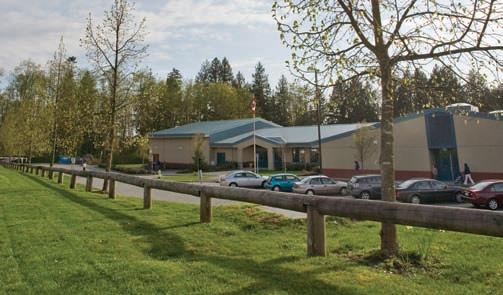
3 minute read
Natural Gas as a Transportation Fuel
BY JEFF CAMPBELL
There is a new interest in natural gas as a transportation fuel in North America, driven by maturing technology for natural gas vehicles (NGV) and a significant increase in natural gas reserves, which drives lower fuel costs. Earlier interest in NGVs was focused on converting gasoline engines to run on natural gas. Today, new heavy-duty natural gas engine technology has been integrated as a factory option in vehicles for a range of applications, including school buses, transit buses, refuse trucks, vocational and urban truck/tractor pick-up and delivery applications.
Natural gas is a clean fuel that offers lower emissions and economic benefits to fleets. While fleets are often motivated by air quality concerns to switch to natural gas, natural gas in transportation also contributes to energy security and can reduce fleet operating costs. NGVs around the world have also had an impressive record of safe operation.
North American natural gas reserves have increased significantly. This increase has been driven by the development of new horizontal drilling and extraction technologies that opened access to shale gas reserves throughout North America, including world-class resource plays like the Montney Formation and the Horn River Shale Formation in British Columbia. The increase in supply, coupled with a focus on energy efficiency, resulted in low commodity prices. In March of 2010, natural gas was $4.30 MBTUs, which is equivalent to $25.80 per barrel, versus $82.90 per barrel for crude oil. This price gap is expected to continue, resulting in significant savings at the pump for natural gas customers.
Natural gas is also the lowest carbon fossil fuel. NGV adoption supports British Columbia’s goals with respect to greenhouse gas (GHG) reductions. Reductions of 20 to 30 per cent in GHG emissions are attainable with the use of natural gas, as compared to diesel-fuelled vehicles.
Natural gas can be used as a vehicle fuel in either compressed (CNG) or liquid (LNG) form. The Cummins Westport ISL G introduced in 2007 is capable of operating on both fuels, and was the first heavy-duty engine to be certified to the strict 2010 North American emission standards. With up to 320 horsepower and 1,000 foot-pounds of torque, the ISL G offers diesellike performance with ultra-low emissions.
This engine technology is available in factory-built natural gas vehicles from: • refuse trucks: Mack, Peterbilt, AutoCar, Crane Carrier and
American LaFrance • transit buses: Daimler (Orion), New Flyer and North
American Bus Industries • trucks: Freightliner, Kenworth and Peterbilt

• school buses: Blue Bird and Thomas (For a full listing of original equipment manufacturer or OEM availability, please visit www.cumminswestport.com.)
Lower fuel costs result in lower costs per kilometer for heavy natural gas vehicles. While there are some differences between natural gas and diesel engine maintenance, the costs are much less than the fuel cost savings. A Cummins Westport natural gas engine is built with over 80 per cent of the same parts as its diesel cousin, so service technicians familiar with Cummins’ diesel engines can adapt to natural gas engine service requirements quickly. Maintenance intervals, warranty and parts support, and engine service training and tools are provided by Cummins. Technicians also provide gas certification for CNG fuel system maintenance.
The first new CNG vehicles to arrive in British Columbia were school buses purchased by School District No. 23 (Central Okanagan), with funding support from Terasen Gas. The first 84-passenger bus arrived in the spring of 2009, and the second, a lift-equipped special education unit, arrived in January 2010. Both buses are equipped with ISL G 250 horsepower engines.
“From all perspectives, CNG fuel is working very well for the district—with good power, fuel range, and economy. Our documented fuel costs for the 84passenger unit is at one half that of a comparable diesel-powered school bus,” says Grant Davidson, operations manager for School District No. 23.
“The payback period for CNG technology upcharge will be approximately four years of operation on a school bus with a life of fifteen years,” Davidson continues. “In addition to this financial advantage, the greenhouse gas emissions are 25 per cent less than that of diesel fuel—an added benefit for the Okanagan Valley and its inhabitants,” he says.
Current district plans include the conversion of a garbage collection truck and a delivery cube van to operate on CNG fuel. 24 Hour Emergency Service

A leader in claims restoration for over 39 years
Your one source for quality & service
Vancouver 604-294-2922
Surrey 604-455-0366
www.barclayrestorations.ca
David Day .........604-690-7016 Dave Torrance ...604-690-6511 Verne Dion ........604-690-7015 Jeff Dean ..........604-690-4911 Kinson Chan .....604-690-7063 Jay Blaak..........604-690-7024 Laurie Fehlauer .604-690-2315 Philip Maxwell ..604-868-0560 Eugene Kim ......604-309-4109










